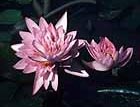Growing Water Lilies
Water lilies are the Juliette Binoche of the garden, says Roddy Llewellyn


All plants are fascinating in their own way, whether in leaf, stem, seed or flower, but water lilies are, surely, the Juliette Binoche of the garden. We all have our own personal likes and dislikes, actresses included, but I consider these water-loving plants to have what is known in the Americas as 'class'. It is because both leaf and flower are so beautiful, the arrangement of both so perfect.
My favourite gardening story concerns the late Christopher Lloyd, who told me once how he saved the life of a precious blue-flowering water lily that needed to have its water kept on the warm side throughout winter. On a very cold night, the electricity failed at Great Dixter, and he rushed outside in slippers and dressing gown to throw his hot water bottle into his renowned sunken pond. He swore that he saved its life.
So special do I consider water lilies to be that I have in the past devoted one entire area to them, in a round pond surrounded by a yew hedge. There were no other flowers in sight to compete with them, nothing else colourful to distract the eye, and there they sat in glorious isolation. I planted them in a pond 18in deep (a good aver-age depth for a small pond), with a diameter of 10ft, and lined it with a black, flexible pond liner. This gave me perfect space for three water lilies that don't spread too much, namely Nymphaea James Brydon (red), Albatros (white) and Sioux (apricot), available from a number of aquatic plant specialists, (including www.thewatergarden.co.uk for James Brydon and Albatros, and www.sweetknowleaquatics.co.uk for all three).
About the only thing that waterlilies hate is disturbance from flowing water. Their large, handsome leaves do help to provide shade and that certainly helps the water from turning into pea soup in still water, although you may also have to add an oxygenating plant such as curly water thyme (Lagarosiphon major), which will need severe thinning every spring. I pull it up by the armful and let it dry a little by the edge of the pool to reduce its weight before adding it to the compost heap.
Nymphaeas are best planted in spring in appropriately sized plastic water baskets, the contents being secured with chunks of upside-down turf. In the absence of turf, you could plant the water lily into a soil-based compost, over which you sprinkle gravel for weight, to prevent it from floating out into the pond. A perfect variety for a larger, deeper (4ft?5ft) pool is Nym-phaea Gladstoneana (white); on the other hand, for a small tub on a balcony, there exist a number of pygmy varieties.
I live in the depths of the country. It is so quiet that I get rather overexcited whenever I hear a car coming up the drive. Every day, I see rabbits, hares, pheasant and deer, and a wide range of birds visiting the bird bath, a garden ornament that provides much better entertainment than the television could ever hope to. When the puddles in the potholes in the drive dry out, the visitations from our feathered friends become ever more frequent. They give me so much pleasure; a sign of being older, I fear.
Opposite my old farmhouse which, according to the legend is the only remaining building of a once prosperous village wiped out by the Black Death is a field of Jerusalem artichokes (Helianthus tuberosus). They are planted densely, as bird cover for the shoot. They remind me of when I first grew these plants (which are natives of North America), while living in London. A friend gave me sacks full of deer droppings to use as fertiliser, which I threw far too generously into the bottom of the artichokes' trench. As a result, I was rewarded with scarcely a handful of tiny tubers, but enormous plants with small, sunflower-like flowers at the top. I only mention this little tale as it taught me the lesson never again to give root crops too much nitrogen.
Sign up for the Country Life Newsletter
Exquisite houses, the beauty of Nature, and how to get the most from your life, straight to your inbox.
Country Life is unlike any other magazine: the only glossy weekly on the newsstand and the only magazine that has been guest-edited by HRH The King not once, but twice. It is a celebration of modern rural life and all its diverse joys and pleasures — that was first published in Queen Victoria's Diamond Jubilee year. Our eclectic mixture of witty and informative content — from the most up-to-date property news and commentary and a coveted glimpse inside some of the UK's best houses and gardens, to gardening, the arts and interior design, written by experts in their field — still cannot be found in print or online, anywhere else.
-
 Vertigo at Victoria Falls, a sunset surrounded by lions and swimming in the Nile: A journey from Cape Town to Cairo
Vertigo at Victoria Falls, a sunset surrounded by lions and swimming in the Nile: A journey from Cape Town to CairoWhy do we travel and who inspires us to do so? Chris Wallace went in search of answers on his own epic journey the length of Africa.
By Christopher Wallace
-
 A gorgeous Scottish cottage with contemporary interiors on the bonny banks of the River Tay
A gorgeous Scottish cottage with contemporary interiors on the bonny banks of the River TayCarnliath on the edge of Strathtay is a delightful family home set in sensational scenery.
By James Fisher